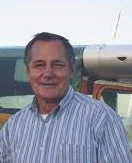What’s Up
3-11-2024
Suggested Banner: Where Can We Land?
Now that we've settled into
springtime, weatherwise, the trees are budding, the birds are moving and the
countryside is greening up. From the air, we see the wheat fields awakening,
snow geese mobbing around and wind socks snapping to and fro in the March
breeze. Welcome rains thwarted flying late last week, but otherwise it was
reasonable flight weather.
Few traffic movements were
seen, slowed by wind and low ceilings, but a few transient planes came by. Jay
McClintock was down from Harrisonville giving dual in his Piper Tomahawk, and
we spotted a Piper Archer or two making their rounds. Local aircraft up were
Les Gorden's borrowed North American T-28A trainer and Roy Conley's
experimental autogyro; the Cessna 150 trainers braved the elements on several
occasions.
It's shaping up to be a disrupted flying year along the
Missouri/Kansas border. Harrisonville airport is closing down on April 8th,
so its large contingent of aircraft owners are seeking temporary lodging
elsewhere. KLRY has already allowed its fuel tank to run empty and will have no
fresh gas until after the runway reconstruction is finished, which will take
all summer.
Meanwhile, we received word that Nevada's airport is being closed
on April 1, for a period of 80 days, in order to refurbish the deteriorated
13/31 crosswind runway, a worthy project but hardly justifying shutting down
the entire 2/20 runway. As with all small-town airport projects, contractors
refuse to cooperate by phasing in work to allow traffic to continue, citing
“liability exposure” and other excuses. At big city fields, of course, they
patch in daylong jobs while planes keep flying.
Butler Memorial is going to be closed for a few weeks this fall,
while the runway lighting system is upgraded to the latest LED technology. We
haven't had working PAPI (precision approach path indicator) lights for years,
due to lack of obsolete parts, and the upgraded fixtures should save much
electricity. Now, if only the automated photoeye governing the lights' turning
on and off could be fixed, so we don't have the beacon turning in late
afternoon.
It's been a good last year for safety in commercial aviation, with
no fatal airline accidents and few mishaps of any sort. That doesn't mean there
weren't incidents, like the infamous departing door plug and a few runway
overruns and damaging hard landings. Just last week, United Airlines had four
happenings; a Japan-bound 777 shed one of its twelve main wheels on departure,
bombing the employee parking lot to smash a car or two, and a 737 had to put
down with a flaming engine. Then, the next day, one of its Airbuses had to put
down with an hydraulic issue and a 737 drifted off the runway after landing,
into the mud. We gotta stop bidding out the maintenance to the lowest
contractor.
In last week's column, we asked readers to define the meaning of
the “UP” code in the visibility portion of airport weather reports, where one
finds S for snow and R for rain. In this case, the “UP” stands for “unknown
precipitation.” Okay, let's continue on to define “GR”, also occasionally seen
as a visibility restriction. Hint; its memory aid name is “granite rain.” You
can send your answers to [email protected].




